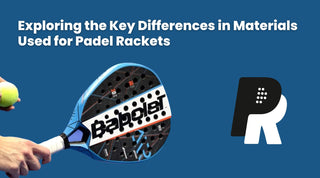When it comes to selecting a padel racket, understanding the materials used in its construction is crucial. Different areas of the racket, such as the frame, core, face, and grip, are made with various materials that impact its performance. In this blog post, we will explore the different types of materials used in padel racket manufacturing, helping you make an informed decision when choosing your next racket.
Frame Material: The frame of the padel racket, which surrounds the face, requires high strength and density materials. The most common frame materials include:
-
Carbon Frame: Carbon fiber offers an exceptional balance of hardness, lightness, and resistance. Rackets with carbon frames are not only durable but also lightweight and easy to use, providing excellent control and maneuverability.
-
Fiberglass Frame: Fiberglass frames are more affordable and commonly used in beginner-level rackets. They offer a softer feel compared to carbon frames but are slightly heavier.
-
Kevlar Frames: Kevlar frames provide even greater strength than carbon fiber, but they are typically found in high-end professional rackets due to their higher cost.
Core Material: The core of a padel racket plays a crucial role in power and control. The two primary core materials are:
-
EVA: Ethylene Vinyl Acetate (EVA) foam is a popular choice for racket cores. It offers a comfortable and responsive playing experience. Different types of EVA foam include Ultra Soft Rubber, Soft Rubber, Medium Rubber, and Hard Rubber, each offering varying levels of power and control.
-
Foam: Foam cores provide a softer touch, minimal vibration, and enhanced bounce. However, they are less durable compared to EVA foam cores, making them suitable for beginners.
Face Material: The face of the padel racket is typically made of fiberglass or carbon. Consider the following:
-
Fiberglass: Fiberglass faces are comfortable and affordable, making them suitable for beginners. However, they are less durable and may not offer the same level of control and power as carbon faces.
-
Carbon Fiber: Carbon fiber faces are lightweight, durable, and provide excellent control and power. Advanced players often prefer carbon fiber rackets due to their enhanced performance.
Within carbon fiber rackets, there are different sub-divisions based on quality and hardness, denoted by numbers such as 3K, 6K, 9K, and 12K. These numbers represent the number of carbon fiber strands in the racket, with higher numbers indicating greater strength and rigidity.
-
3K Carbon Fiber: The most common type, offering lightweight construction, control, and comfort with slightly less power.
-
6K and 9K Carbon Fiber: These provide more power but slightly less control compared to 3K carbon fiber rackets.
-
12K Carbon Fiber: These rackets are more affordable but sacrifice some control for increased power.
Understanding the differences in materials used in padel rackets empowers you to make a more informed purchasing decision. Consider your skill level, playing style, and budget when choosing the right material combination that suits your needs. Experimenting with different materials will help you find the perfect racket that enhances your game on the court.





